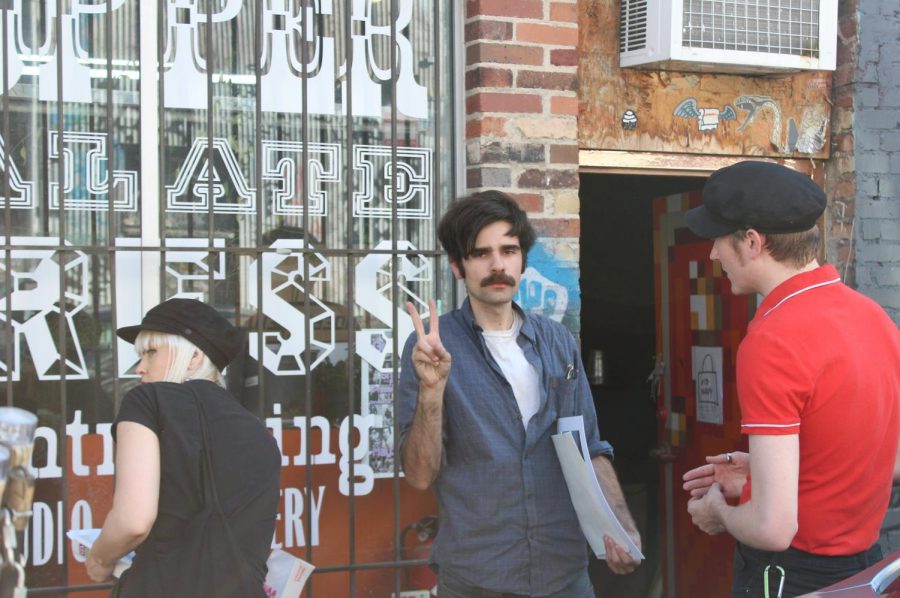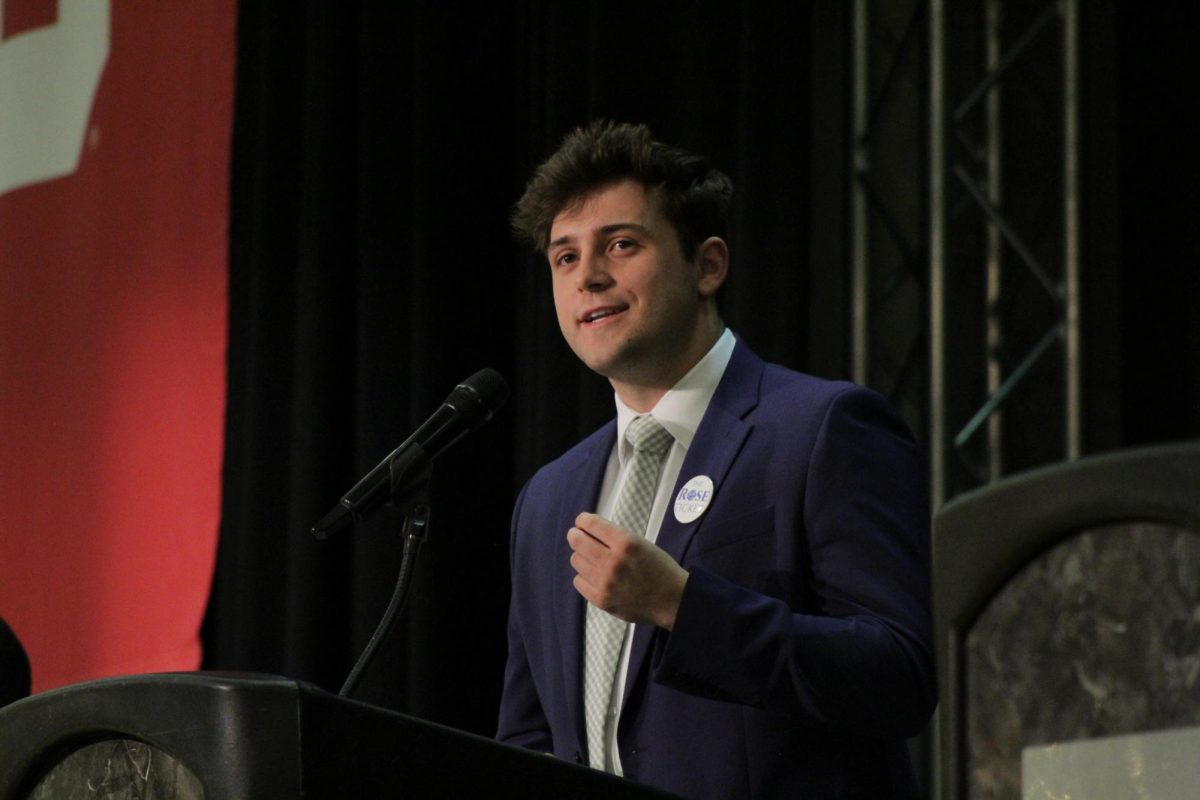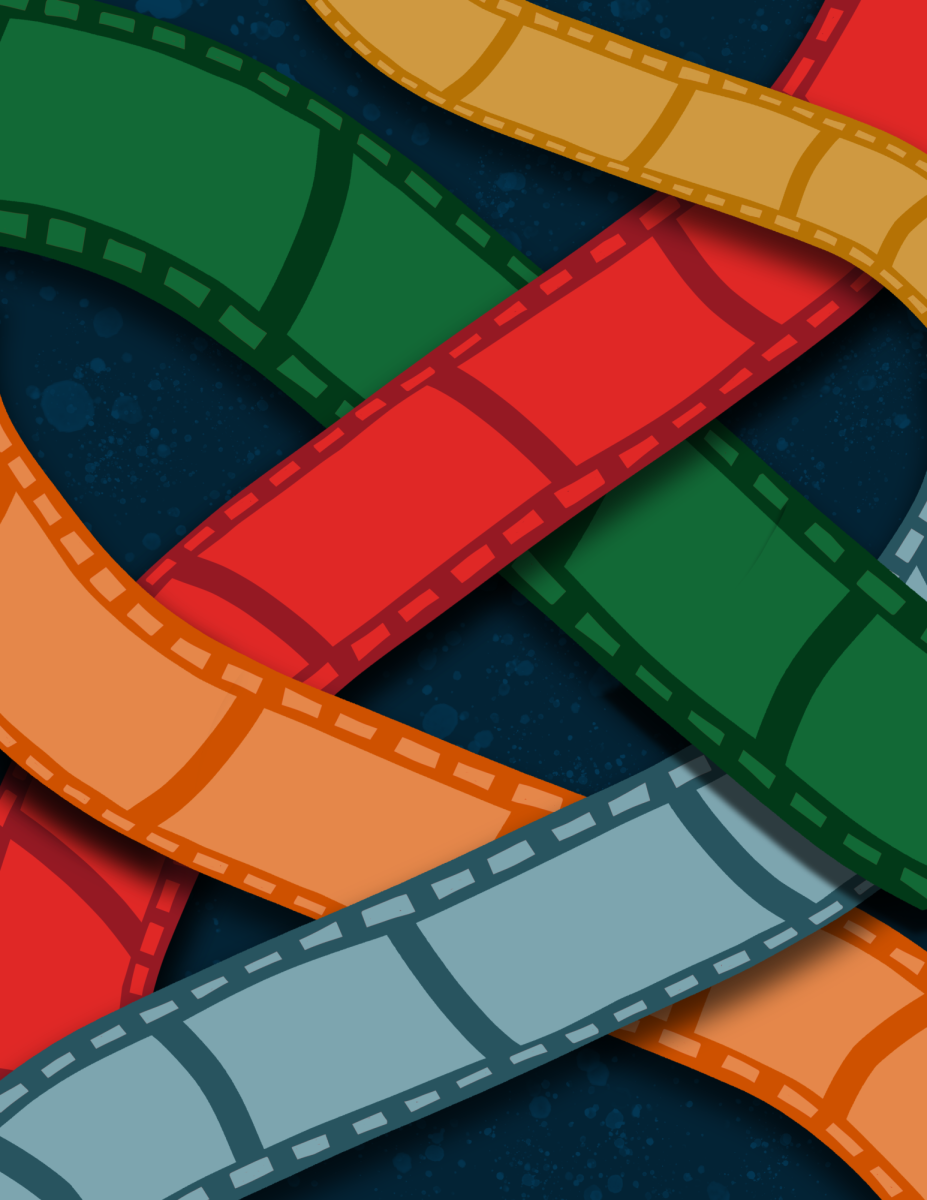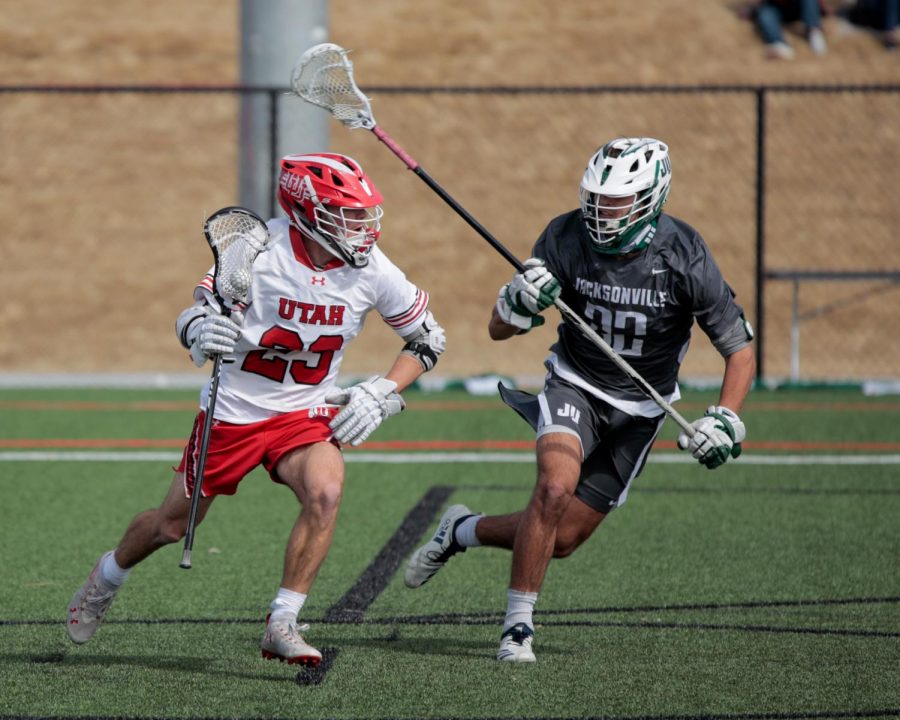Art Against Doom: Creative Activism in the Face of Climate Change
The artists and organizers of Art Against Doom gather together at Copper Palate Press to get ready for their Sept. 20 show. (Photo by Matt Gubler)
September 18, 2019
If you’ve ever taken a course in the Carolyn and Kem Gardner Commons, perhaps you’ve seen a large installation — up on the second floor — of a quote from pop artist Andy Warhol printed along a wall of frozen clocks. It reads, “They always say time changes things, but you actually have to change them yourself.” Obstacles such as racism, ableism, sexism, homophobia and other prejudices are not as severe today as they once were only because of those who fought to improve the world in the first place. The future is nothing but potential until those living in the present claim it. One team of artists and activists in Salt Lake City are doing just that. They’ve banded together to tackle one of the most divisive and pressing problems of our era — the issue of climate change — through the upcoming grassroots exhibit “Art Against Doom.”
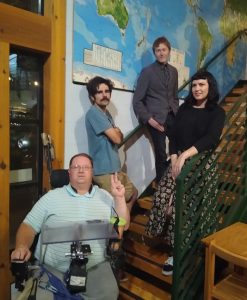
On Sept. 20, from 8 p.m. to 1 a.m., art lovers and flaneurs alike are invited to engage in this free of charge and all-ages community dialogue of art, poetry, music and live performance at Copper Palate Press, a local print shop and gallery. The displayed works, all of which share themes of environmental justice, will also be put up at a charity auction to support two Utahn nonprofits — SLC Air Protectors, a Native American-led organization dedicated to promoting clean Utah air quality, and the Utah Permaculture Collective, a group that promotes sustainable agriculture and teaches gardening workshops to neighborhoods in need.
To learn more about what a project like Art Against Doom means for the future of art and activism in Salt Lake City, The Daily Utah Chronicle reached out to the team. Artists and organizers alike spoke with us about how social awareness and creativity are inextricably linked and how we can all do more to protect and improve the environments of Utah.
Contemporary Viewpoints on Climate Change
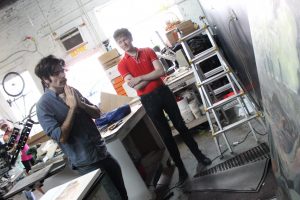
Stephen Christian, a PhD student in the Political Science Department at the University of Utah, is volunteering as one of the organizers of Art Against Doom. “Humans have heard climate change is a big problem and what we’re trying to say is that it’s more than that,” he said. “You don’t just have the people who deny climate change. You have, also, those sort of quietists. Those individuals who don’t want to contemplate the disastrousness of everything.”
Christian proposed that art is an important key to resolving these attitudes and opening doors to real change. Those who believe that saving the environment is an impossible goal, he said, “lack the will or capability or imagination to start thinking how to fix it.”
“Our axis is in aesthetic interruption,” Christian said.
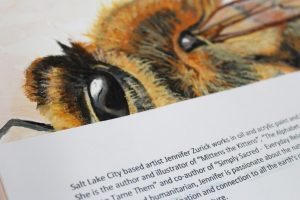
Another organizer and show emcee, DJ Nix Beat Nicholas Augustus Roswell Kuzmack, said that Art Against Doom reflects Utahns’ attitudes about environmentalism. “We’re working to invite action on the air quality we suffer here every year that causes long term health issues, not just to us — human beings — but to the environment as a whole,” he said. He hopes Art Against Doom will “also inspire action against the [SLC inland] port [which will] bring harmful things, fossil fuels, into our state.” Tackling climate change is a tense issue in Utah. Rallies against the possible inland trucking port have resulted in police violence towards resisting protestors, but Kuzmack believes that art can convince people to join the cause. “Art is a powerful way to tell stories, inform people and shock people,” he said.
Creativity for a Cause
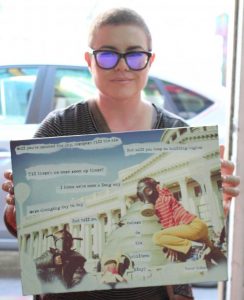
Cat Palmer is one of the artists participating in Art Against Doom. “I’m an art activist, specifically [using] photography and mixed media,” she said, and she has been working for 14 years. “This piece I did is with my children at a Clean Air Rally,” she said, gesturing to the photo collage that she donated to Art Against Doom. The work depicts her kids sitting at the steps of the Utah State Capitol while wearing gas masks. The heart-wrenchingly beautiful piece depicts how bleak, poisonous and warlike Salt Lake City’s polluted skies are bound to become for these children if the state allows air quality to further deteriorate.
For Palmer, art is a strong visual vehicle to help audiences and onlookers to feel as she does about environmentalism. “I try to use my work to bring awareness and start conversation and dialogue,” said Palmer. “People don’t care enough about the air quality here in Utah.” She specifically invites U students who hope to pursue the arts to pursue activism in their work. “I would love to see more people using their voice and platform and shaking things up,” Palmer said. “And I would say nothing is off-limits and to push that envelope. I would love to see more feathers ruffled in the city.”
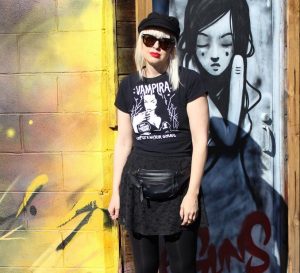
Kady Newland, a tarot practitioner and exhibit organizer who will DJ the show, said that running an art show in the name of environmental activism can create a tangible impact on Utah climate. While “this show seeks to bring awareness,” she said, it also serves “to raise money and have a direct impact.” Newland emphasized that the pieces and performances featured in the exhibit will provoke viewers to consider what environmentalism means in their own lives. “People in our community are nihilistic and would rather just check out because this is something that’s scary,” she said. “I mean, we want to open a door up. We want people to stop and consider the issue of climate change.”
Intersectional Action
While environmental damage is harmful to everyone, it is also a threat that uniquely targets victims. Indigenous people have their lands unethically seized by United States governments to mine and drill for oil. Low-income families and people of color are often driven to live in neighborhoods plagued by toxins, as notoriously highlighted by the water crisis in Flint, Michigan. Disabled individuals are also often harmed by climate change and pollution.
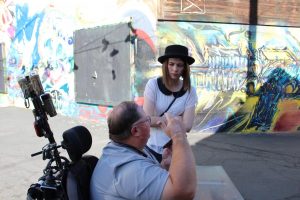
For exhibit organizer Adam Guymon, disability advocacy and environmentalism go hand in hand. Public transportation doesn’t only improve air quality, but leads to better integration of disabled people into society. “Climate change harms people with disabilities and without disabilities, in the fact that public transportation should be something that should be available to everyone,” he said. Guymon argued that public transport needs to reach not just throughout Salt Lake City but throughout the state of Utah, needs to be financially accessible and needs to be consistently accessible to all riders. Guymon said that the lack of that transportation bars disabled individuals such as himself from more easily living day to day life or from experiencing Utah events. “It’s not accessible if you can’t get there,” Guymon said. “Public transportation should be a right, not a privilege.”
Art is particularly important in fighting for disabled rights, according to Guymon. “Art can be, in many different ways, a way of expressing how a person feels, what’s inside them. It connects what you’re doing to what someone wants to see,” he said. “Most other people do not understand what the disabled perspective is or what [disabled people] are going through, and art is a way to express that.”
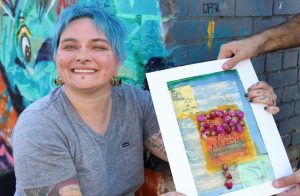
Psarah Johnson has also volunteered her time towards launching Art Against Doom on behalf of the Disabled Rights Action Committee of Utah, of which she is a chairwoman. “We were approached to be involved with this particular piece because organizers really understood the intersection between climate change, environment and the toll it takes on our lives,” she said. Johnson said that her own father’s health had once seriously suffered from poor air quality in San Diego, and those with illnesses or disabilities may suffer from painful symptoms induced by pollution. Johnson said it’s vital “that we are aware that people who have chronic conditions should be considered when we’re looking at our mutual environment.”
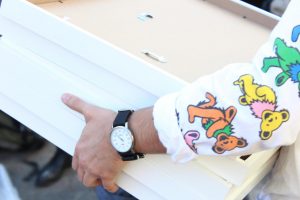
Rising Artists and Youth Can Become Environmental Heroes
For the future of environmental justice, Christian feels that many rising artists and members of the world’s newest generations have a special opportunity to demand solutions. “I feel like Millenials have felt hopeless about this as well. It seems like [environmentalism] is primarily a Gen-Z issue,” he said. “I think that so many of the consequences are going to be so impactful for so much of their lives that it makes sense why they care so much about it.”
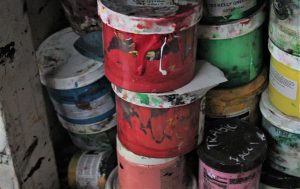
Many may harbor that sense of hopelessness towards the possibility of achieving environmental justice. Christian described the feeling as inevitable, but not undefeatable. “I don’t want to say, ‘Oh, it’s about having a positive attitude,’ more than it is about ‘Assess the situation you’re in,'” he said. He suggested that we should “think about what you are able to do in this micro-scale,” for your local community and environment. Tackle this global issue within your own range of influence and reach. Solving climate change needs all types of creativity outside of artwork alone, he added. “It’s going to require provocative actions… It’s going to require resistance. It’s going to require individual acts of civil disobedience. It’s going to require collective organizing, in whatever way, shape or form that is.”
An earlier version misstated that Stephen Christian is currently a TA, and the roles of Nicholas Augustus Roswell Kuzmack and Kady Newland in exhibit participation have been clarified.


